Passing Through Las Palmas – Part I
In which we encounter the Biggest Yacht, the Tallest Yacht, and an Innovative, Inspirational Solar-Powered YachtYou meet some nice people cruising. Nice people, and interesting boats.
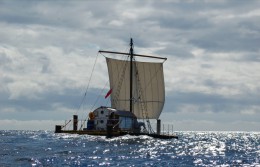
A few months ago we happened upon a multi-national team of English, Indonesian, and South African nationals who were sailing a Phoenician ship around Africa. And then we ran into a bunch of really crazy guys who were just about to set off across the ocean on a plastic raft.
One of the best places to see a wide variety of interesting boats is Las Palmas, Gran Canaria. The Canaries being the seafarer’s stepping stone on the way from Europe to the Americas, and Las Palmas being the best place to stock-up with food or to get things fixed, hundreds of vessels pass through this port each winter.
Amongst the bigger boats, heading for berths at the far end of the docks, we spotted several famous names:
Tallest
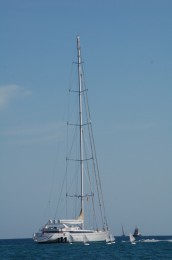
Mirabella V came through, both this past November (2010) and the one before. At 247ft (75m) long she doesn’t take the award for the longest yacht in the world, but she is reputed to be the one with the tallest mast. It certainly towers above anything else in the vicinity, and friends approaching the port in their own yacht were very puzzled as to what they might be seeing: surely, they reckoned, it was too big to belong to a yacht?
If you’d like to click on the adjacent photo it will suddenly treble in size and you’ll be able to take a better look at some of Mirabella‘s deck fittings. Just cast your eyes over the roller-furling units. Those little white dots nearby are the crew…!
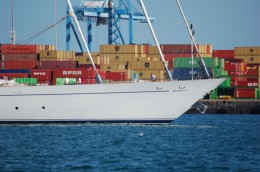
Mirabella belongs Joe Vittoria, the former Chairman and CEO of the Avis car rental company. Not a bad business to be in, it seems. Perhaps if we ask him he’d give us all reduced rates, seeing as we’re fellow yotties…
Biggest
This winter we also spotted a super-mega gin-palace by the name of Eclipse. Eclipse belongs to a Russian crook called Roman Abramovich.
Oops, sorry – he’s not a crook anymore; he’s a business man and sometime politician. Having started his career by smuggling black-market goods into Moscow, Abramovich subsequently founded an assortment of factories, stole a train-load of fuel, paid huge bribes in order to gain control of oil and aluminium companies, and became so wealthy that the Soviet government felt obliged to befriend him and give him a pat on the back. Thus he was given an apartment in the Kremlin and became the governor of one of the Russian states.
Eclipse is so called because that’s what she does: at 560ft (170m) she’s the biggest privately owned yacht in the world, and as such she eclipses all rivals. (Well, Mirabella isn’t so very much better, as a name, is it? It means Nice-View, or words to that effect.) Eclipse boasts two swimming pools, two heli-pads, and a submarine.
Mr Abramovich also owns a number of other smaller vessels, various choppers, a Boeing 767, one each of every flashy sports cars you’ve ever heard of, two bullet-proof bomb-proof cars, Chelsea Football Club … Oh, and a house in Rogate, of all places.
To be fair, the man has also spent more than more than a billion dollars of his own money on schools, housing, and health-care in the state of which he was governor; but when you’re worth 13 billion US dollars that probably doesn’t hurt too much.
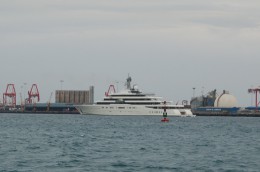
When we saw Eclipse enter Las Palmas, dwarfing the container ships moored on the quay behind her, we guessed that we would be able to learn all about her on good ol’ Wikipedia. Reading the entry as the yacht slid past the anchorage we discovered that she is protected not only by all the usual alarms but also, allegedly, by a device which makes it impossible to take photos of the vessel.
Well…! Naturally, upon reading this we ran to fetch the camera. We composed the shot; we focused; we released the shutter; and – nothing!
Absolutely nothing happened.
No gigantic flashes or other emissions were observed from the ship, and the seven million pixels did their usual thing and faithfully recorded this somewhat uninspiring view of the biggest yacht in the world.
Disappointing, hey? From several points of view.
Bestest
One of the more interesting vessels to pass through Las Palmas this winter was the world’s biggest solar-powered boat. Now, regardless of what you may be thinking, based on what you have read so far, I don’t generally care a toss about the biggest this that or the other – but when it comes to solar power we really are talking about something special.
While Comrade Abramovich and Mr Avis are helping to guzzle down the world’s oil reserves (the latter to a lesser extent, one supposes) the owners of this sun-driven thing are leaving a clean, green wake.
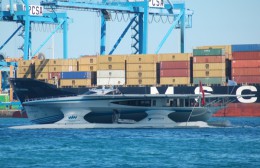
Turanor is a weird and truly wonderful machine. At first glance she could be mistaken for a super-snazzy petrol-propelled motor yacht; or for a night club, or a top-secret fighter jet, or for something that just landed from outer-space.
The vessel is roughly triangular in shape when viewed from above. The main cabin, if such it can be called, is reminiscent of a restaurant dining room or a posh yacht club; it has French windows on all sides. The wheelhouse, as one might call it, is actually more like the cockpit of an aircraft. However, the thing that really catches one’s attention is the fact that the whole lot – deck, glazed cabin, flared hull, and all – is raised up on stilts.
Why Aren’t Cars and Container Ships as Efficient?
Turanor‘s outlandish shape has more to do with aerodynamics and other technical considerations than it has with style – although the result is undeniably very stylish.
Because the bulk of the boat is out of the water, drag is kept to a minimum. And the craft is shaped like a formula one car or a fighter plane for much the same reason: in order that she should flow easily through the air.
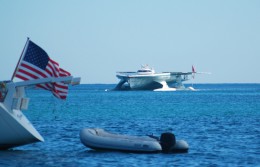
When your vessel is being driven along by the sun then it is important that she be super-efficient. Mind you, it seems to me that there is no good or logical reason to explain why the designers of solar-powered boats and cars should be more concerned about this issue than the chaps who create the world’s oil driven fleet. After all, the sun is not going to run out, even if it might pop behind a cloud for a few hours. Oil supplies, on the other hand, are a finite resource, and their use is one of the major causes of global warming and of impending doom for all life on earth – including short-sighted Messrs Abramovich and Vittoria and nice people like you and me – so, shouldn’t the designers of our petrol and diesel driven cars, lorries, boats, and ships be even more concerned to shape them in ways which allow the maximum value to be made of each deadly drop of fuel?
Let’s All Go Solar!
Turanor‘s deck is built in such a way as to provide the maximum area in the most aerodynamic shape, but this huge expanse, floating high above the sea, is not designed for sunbathing; or rather, it is – but the sun-bathers are not long-limbed blondes; they’re photovoltaic solar-panels. Yes, it’s as simple as that: Turanor‘s deck is entirely carpeted in solar-panels of the sort that yotties regularly use to provide electricity for their lights and computers. The solar panels fuel lithium ion batteries which, in turn, power an electric motor.
So – all we need to do, if we want to be able to keep on going when the wind dies or punch up-wind into the teeth of a gale, is lay out 500 square metres of solar panels on the deck.
Unfortunately, this would also involve laying out around £500,000. And it would all be to little or no avail unless we also ditched the diving compressor, Nick’s half-a-ton of tools, and sundry other heavyweight items including the windsurfer, the hard dinghy, numerous wetsuits, 800 books, a djembe, two other drums, my shiny new saxophone, Roxanne’s collection of shells, skulls, and other animal remains, several reams of watercolour paper, a large folio stuffed full of paintings… “Hey, come back with my paintings! Hmmmm… Look, this isn’t going to work.”
Against the Sun
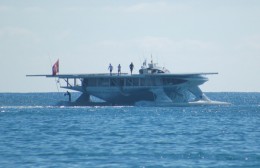
There would, of course, be no need for fuel tanks if we went solar – they, and their dirty, smelly, heavy content could go – and one would also need to do away with the water tanks and invest in an efficient, reliable, electrically-powered watermaker. However, the biggest change would be to the boat itself: it would need to be made of something much lighter than steel. And it would need to be cunningly shaped … like Turanor.
A lightly built solar-powered yacht wouldn’t be strong enough to battle its way through the Southern Ocean.
And one wouldn’t be able to run up and down on its panel-covered decks.
We couldn’t host wild, crazy parties on a surface of the delicate silica crystals.
And I can just imagine how the Engineering and Electrical Department would react when the dog pooped on the panels, or the Artist spilled splashes of paint here and there:
“Oh, come on; it’s only a couple of blobs; it won’t make any difference!”
“But it will! Each one of those blobs of paint short-circuits that entire section of the solar panel.”
The Wind Wins
On second thoughts, I think we’ll stick to wind power. It’s cheaper, by a long way, and it’s strong enough to haul around 28 tons of barnacle-clad boat.
Wind Power – tested over two millennia; ecologically and environmentally sound; no harmful side-effects; guaranteed for life; does not contain nuts. Your money back if you are not completely satisfied.
Setting an Example
Meanwhile, Turanor – in the interests of advertising the advantages of sunshine – is taking a turn around the world.
31 metres long and weighing around 90 tons, the vessel is nevertheless said to draw only one and a half metres. If this is really true then there is almost nothing dragging in the water!
The designers plan that their strange creation should travel along at around 7 knots. The voyage is expected to take around 160 days, and the crew of six will receive weather routing information via satellite communications. This is standard procedure nowadays for yachts racing around the world, but in this instance the meteorologists will not be hunting for fair winds but for clear skies. If the experts fail in their duty and panels go without sustenance then the energy stored in Turanor’s batteries will enable her to continue at reduced speed for up to 15 days. In fact, she can even continue at full speed for up to 3 days.
The vessel’s name is taken from Tolkein’s Lord of the Rings and means “power of the sun” – which is appropriate enough. Her owners say that their intention is not really to revolutionise commercial shipping – they recognise that a solar-powered boat of this type lacks load-carrying capacity – but they want to demonstrate that the technology to travel using nothing more than the sun already exists: the boat was not built by scientists and the technology employed in its construction is already on the market and is available to everybody.
So – the old adage is wrong: you can live on sunshine. Provided that you can afford the means to harvest it.
And That’s Not All
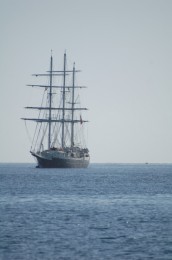
These are just three of the weird or wonderful boats which have passed through Las Palmas in recent months. Square riggers pop in and out on a weekly basis – there are sometimes two or three in port at the same time – and we have also seen a couple of Fifes and a J.
The harbour also houses a huge fleet of sailing dinghies which flit about alongside the ships like a cloud of butterflies drifting across a garden. Many of Spain’s Olympic medals have been won for sailing, and a good few of the medalists hail from this city; thus, the people have been inspired to want to teach dinghy sailing to every school child.
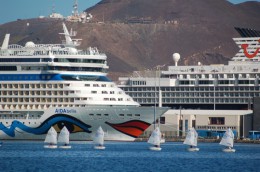
The harbour also hosts international meetings and regattas, and it is home to a local racing boat which – so far as I am aware – is unknown elsewhere. Based on the traditional working boat which is still to be seen on the Mediterranean coast of Spain (albeit only as a plaything), the Las Palmas version of the vessel has been allowed to develop. The hulls are now lightly built and their traditional appearance hides a secret: nowadays the boats have fin keels! Their semi-traditional sails are tall and, most exciting of all (in my view) the crew are allowed to sit the boat out using a kind of primitive trapeze. The men racing in the Mar Menor, in Spain, sit their boats out by hanging over the side, but in Las Palmas the guys hitch themselves to the mast with colourful webbing straps and put their whole weight outboard. Half a dozen guys all hitched to the mast like maypole dancers!
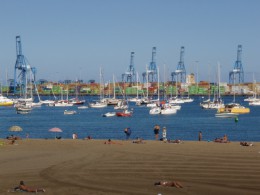
Besides the cruising yachts and the local craft Las Palmas is also frequented by a great variety of commercial ships which come and go all day long and even during the night. There are small container ships and massive container ships. There are ferries plying the route between Spain and the Canaries or between this city and the other islands. There are ice-breakers in for repair or refurbishment; cable-layers; floating docks with another ship sitting on their deck; oil tankers and oil rigs; and there is a whole host of rusty purse-seiners, decrepit trawlers, and ship-sized factory boats (which process the catch out at sea, thereby enabling the fishing fleet to continue their rape and pillage of the ocean without wasting time travelling to and from the grounds).
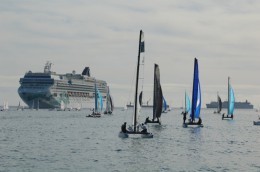
There is also an endless stream of stunningly ugly cruise ships – each one looking like the biggest, baddest block of flats you ever saw – which bring thousands of tourists to experience the delights of Las Palmas.
I wonder how many of them notice the oil colouring the water, or the smoke issuing from the tugs and inter-island ferries, or the notices on the beach which warn people not to swim after the sewage has overflowed.
More on this subject on another day.
More too on the Cruising Scene in Las Palmas.
